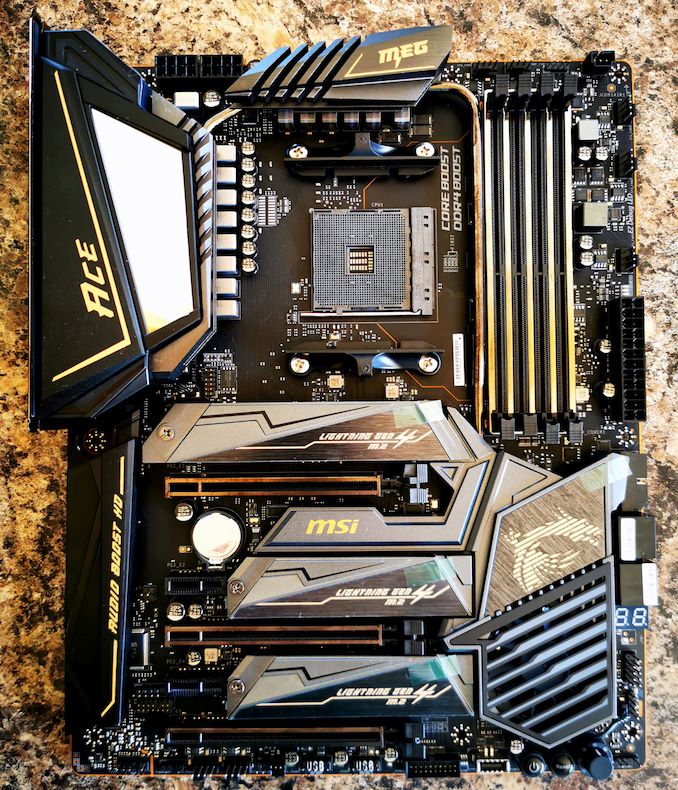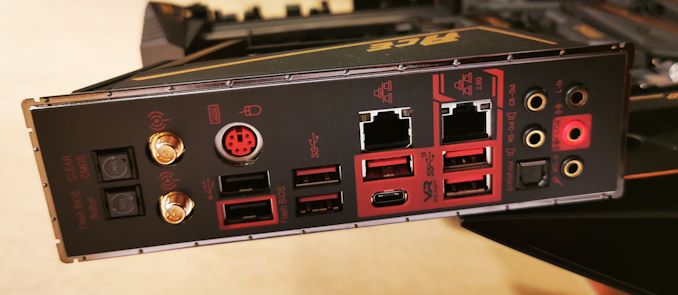The AMD X570 Motherboard Overview: Over 35+ Motherboards Analyzed
by Gavin Bonshor on July 9, 2019 8:00 AM ESTMSI MEG X570 Ace
Our full review of the MSI MEG X570 Ace is currently live with many more X570 models set to be fully reviewed and analyzed over the next couple of months.
The MSI MEG X570 Ace motherboard represents its premium MEG range and as we've seen from its range on the Intel Z390 chipset, MSI has followed the same naming structure for users to easily identify which each range signifies. The X570 Ace benefits from an Intel Wi-Fi 6 wireless interface, a Realtek 2.5 G NIC, three PCIe 4.0 x4 M.2 slots, and a 12+2 power delivery. Like all of MSI's X570 product stack with four memory slots, there is support for up to 128 GB of RAM.
The board has four DDR4 memory slots with support for up to DDR4-4600, three full-length PCIe 4.0 slots which operate at x16, x8/x8, and x8/x8/x4, with an additional two PCIe 4.0 x1 slots. Built into the X570 chipset heatsink is a cooling fan which uses MSI's Zero Frozr design as the X570 chipset has a rated TDP of up to 15 W. Providing power to the CPU is two 8-pin 12 V ATX power inputs, while the power delivery is using an extended 8 to 6.5 mm heat pipe which extends from the power delivery directly down to the chipset. The MEG X570 Ace has three PCIe 4.0 x4 M.2 slots, each with its own individual Lightning Gen4 M.2 heatshield which amalgamates into the boards black and gold designed heatsinks. Like the MSI MEG X570 Godlike, MSI's RGB Infinity Mirror 2 is present on the rear panel cover to allow users to customize the look of the board.
On the rear panel of the MSI MEG X570 Ace motherboard, there's a clear CMOS, and BIOS flashing button which has its own dedicated USB 3.1 G1 Type-A slot highlighted with a red outline. There are three USB 3.1 G2 Type-A ports, a single USB 3.1 G2 Type-C, two USB 3.1 G1 Type-A ports, and two USB 2.0 ports. Networking capability consists of a Realtek RTL8125AG 2.5 GbE NIC with the other Ethernet port being controlled by an Intel I211-AT Gigabit NIC. This model also includes integrated Wi-Fi with an Intel AX200 Wi-Fi 6 802.11ax wireless interface which also offers users with Bluetooth 5 connectivity. The five 3.5 mm audio jacks and S/PDIF optical output are driven by a Realtek ALC1220 HD audio codec.
The MSI MEG X570 Ace in terms of price and feature set is quite impressive and with an MSRP of $369 which makes it a highly competitive when compared with other models in its price range. The need for MSI to upgrade its networking capabilities on desktop motherboards is something they have started to implement, and the rear panel on the X570 Ace is also without video outputs so users looking to use Ryzen based APUs will need to look elsewhere.












225 Comments
View All Comments
abufrejoval - Tuesday, July 9, 2019 - link
It's amazing how quickly you run out of PCIe lanes, when you don't have switches to multiplex and translate between PCIe revisions and lanes (e.g. PCIe v4 x2 <-> PCIe v2 x8).I find myself using USB 3.x NBase-T NICs and NVMe adapters, simply because they *do* switch.
Bensam123 - Tuesday, July 9, 2019 - link
Maybe a bit more depth on the power delivery page. I have absolutely no idea how to go about parsing what's there. More chokes is better? What denotes a power phase?A5 - Tuesday, July 9, 2019 - link
+1. Some analysis of that information would be helpful.MrSpadge - Tuesday, July 9, 2019 - link
+1bunkle - Wednesday, July 10, 2019 - link
The controller column includes the total number of phases supported split between CPU cores and SoC e.g. (6+1) = 6 CPU phase and 1 SoC phase. More is *usually* better but has diminishing returns regarding tighter and tighter voltage regulation. Some controllers are better than others (can operate at high frequency e.g. 500KHz v 1000KHz, include other features to improve performance) mitigating the need for more phases.Each phase is a buck converter comprised of a low/high side MOSFET (can be integrated in a single package) and choke. Some controllers can support doubling up the PWM signal to driver more MOSFETs. Doublers can also be added as discrete components if not built into the controller.
Current rating of the MOSFET (e.g. Sic639=40A IR3555=60A) indicates the total power deliverable. MOSFETs are not 100% efficient and vary in efficiency. The more current they provide the hotter they get and the less efficient they become, with better MOSFETs producing less heat for a given current. Thus using doubles can improve temperatures and efficiency without the benefits of the tighter voltage tolerance that *real* phases provide.
Hope that’s helpful!
bunkle - Wednesday, July 10, 2019 - link
A lot more detailed explanation: https://en.wikichip.org/wiki/voltage_regulator_mod...bug77 - Tuesday, July 9, 2019 - link
The description for AsRock X570(M) Pro4 says "5 jack + 1 SPDIF". Unfortunately, those boards lack SPDIF and only come with 3 jacks ;)Smell This - Tuesday, July 9, 2019 - link
I'm thinking the *ASRock Thunderbolt AIC* ...https://thunderbolttechnology.net/product/asrock-t...
would cover all your TBT peripheral needs, including optical.
DanNeely - Tuesday, July 9, 2019 - link
Do X570 boards still need an extra chip per USB port to support USB-C reversibility?The additional expense and needed PCB space were cited as among the reasons why earlier generation boards (IIRC both Intel and AMD) almost never had more than 1 C port; but it was never clear to me if that was an inherent implementation penalty for the C port or an artifact of Intel's tech stack being stalled out and AMD outsourcing to ASMedia which built the chipsets on an ancient (55nm) platform.
DigitalFreak - Tuesday, July 9, 2019 - link
Gavin - X370 and X470 only supported PCIe 2.0. The connection between the CPU and chipset was 3.0, but all the ports on the chipset were 2.0.